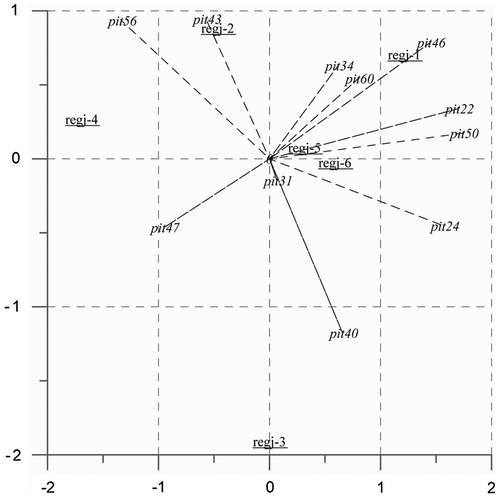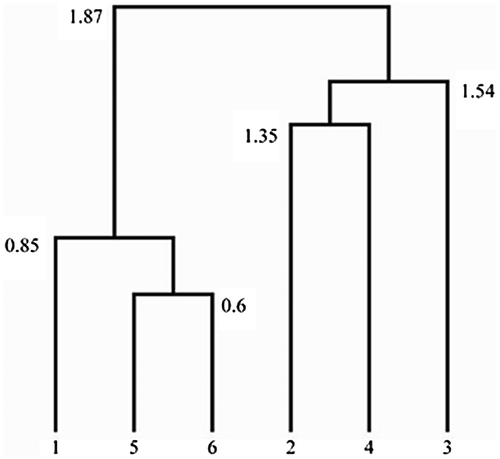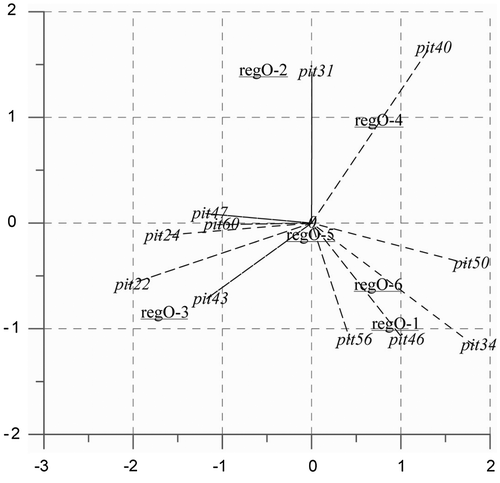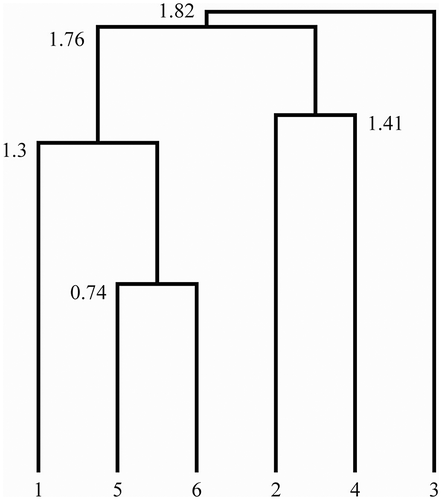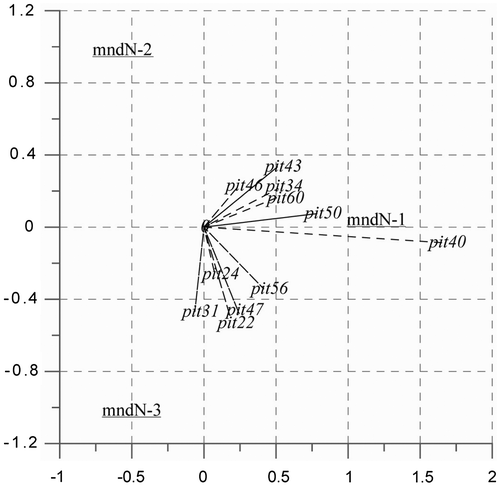Abstract
The paper is an analysis of individual values of employees carried out on the basis of the Schwartz theory of basic human values. On a sample of 1166 respondents from a population of six European countries (Croatia, Hungary, Italy, Romania, Serbia and Slovenia) it has been shown how individual values in organisational context can be used in a form of value profiles at regional level. Individual values of employees in companies and local government units were analysed. The research showed how value profiles can be formed and how they can contribute to increase managers’ awareness of human resources potentials and thus increase human capital of an organisation. Croatian and Serbian value profiles show similarities, while Romanian and Hungarian employees’ profiles are more distinctive. Values of stimulation and tradition dominate at top management positions.
1. Introduction
Successful organisation and, beyond, successful society are based on good assessment of the ability of individuals and organisations to exercise their functions efficiently, effectively and sustainably. Organisation, to a greater or lesser extent, may affect the actors inside and outside of it to work towards a predetermined goal in all aspects, not only from the technical side, but also considering all the resources available (financial, human, material, technical and technological, informational), and also all systems, processes, procedures, norms and values.
This holistic approach assumes that the whole is always more than the sum of individual parts. For example, if an organisation has a qualified and trained staff it needs to use a certain management system to manage these resources and must determine a set of values, norms and preferences which they share. We know from experience that it is not enough to have great financial resources if they are not used properly.
There are statutes and regulations that seek to draw attention to the principles of good practice in the management of organisations, companies and local governments. This process leads to the development of a modern system of private and public services in which values, merit and achievement underlie the choice of an individual for a certain position and professional progress, while created conditions and rewarding contribute to competence. For example, when the communist way of organising public services was replaced by a new value principles, there was a resistance to adapting to democratic legal framework and democratic values, but also problems with coping with fundamental changes in values, attitudes and beliefs of politicians, employees in the executive branch, in the public sector, private sector and citizens in general (Randma-Liiv, Citation2005).
Organisations are always more complex than their organisational scheme or what is (in the case of public administration) normatively defined in their internal regulations (rules). Experience shows, for example, that the influence of informal authority and a system of values is sometimes higher than what we consider official and obvious. Specific relations in the processes of human resource management, communication, image, identity and vision of an organisation as a framework for value system, often make the difference between successful and unsuccessful organisations, successful and unsuccessful management, successful and a failed articulation of the vision of the organisation and a successful and unsuccessful path towards achieving this vision (Milosavljević, Citation2005).
Organisations should never start the process of capacity development with no previous experience of basic research into its values and attitudes, particularly its organisational culture, the cultural diversity of employees and the value capacity of organisations (Henderson, Citation1994). That is why managing values is indispensable for effective management of organisations. Research into articulation of a company’s values and their alignment with the personal values of employees and their orientation towards results, is increasingly becoming a part of the link between corporate strategy and change management (Jovović, Citation2006).
Since values are increasingly seen as motivators (in successful organisations, employees are aware of the values and motivators that coincide with organisational values) there is a need for the management of values. Managers are facing the challenge to find the values of employees and so motivate their employees better. Value management means management of a company’s organisational culture and serves to strengthen and revitalise the company so that it can easier cope with the changes (Dolan & Garcia, Citation2002; Dolan, Garcia, & Auerbach, Citation2003).
Individual values are diverse and difficult to ‘catch’ in order to explore their contribution to the group, organisation or a company, and thus to successful businesses and services. How can individual human values be explored and grouped to be used in human resource management? What prevalence of value dimensions can be taken into account when deciding on investments in human resources? This research is aimed at entering the corporate world and obtaining samples in selected countries of South East Europe (old, new, newest members of the EU and a candidate country) to get a ‘value snapshot’ in such socio-economic and political environments, to identify the differences between employees in selected countries and offer a specific usability of employees’ values as a workforce quality element. Additionally, our research included staff of businesses and municipalities where those businesses operate, thus giving a complete picture of a value profile in a particular geographical region. The specific value of this research is that we collected samples of employees in companies and local governments while being at their workplaces. Our research also includes a significant number of top management respondents, thus offering a perspective on the issue of value differences between low, middle and top management.
After this introduction, which presents the research setting, the paper offers an overview of the value dimensions as a management tool and how they have been perceived as a founding element of the organisational culture in two major theories. The paper then shows how our research fits into the theoretical context and methodological framework it follows. After the presentation of results, the conclusion, with the contribution of the research results, is presented, followed by practical implications of results, limitations and further research directions.
2. Individual value dimensions in management
Geert Hofstede’s research, one of the largest empirical studies on national culture in the world, is well known to be the research mainstream when investigating how culture affects values in the workplace (Hofstede & Hofstede, Citation2005). While Hofstede has focused on one value dimension, Individualism (among Power Distance, Masculinity, Uncertainty avoidance and Long term orientation), Shalom Schwartz has taken a different approach. His Theory of Basic Values (Schwartz, Citation1992, Citation1994) is based not on receiving preferred answers from respondents, but how they feel about the importance of certain values to them personally as ‘guiding principles of their lives’. Schwartz’s work involves testing two levels: analysis of individual values and analysis of cultural values. This is the biggest difference compared with the works of Hofstede who does not offer a clear distinction between these two levels.
Schwartz very clearly separates value types and value dimensions. Although this difference is similar to Hofstede’s work, Schwartz is clearer. The value type is, generally speaking, a set of values that conceptually can be combined into one comprehensible description: for example, egalitarian commitment. The values of this type contain other values which are located at the opposite pole. So, in the case of egalitarian commitment, it would be a hierarchy at the cultural level. Together, these two values are creating a value dimension ‘egalitarian commitment versus hierarchy’. This setting is something similar to, for example, Hofstede’s individualism vs. collectivism, which, when combined, provide the value dimension of individualism vs. collectivism. However, the difference between value types and value dimensions is clearly defined and disclosed in Schwartz’s work.
Studies have assessed Schwartz’s theory and conducted validation with data from samples in 82 countries (representative national samples from 37 countries). The samples include diverse geographic, age, gender, occupational, cultural and religious groups (Bilsky, Janik, & Schwartz, Citation2011; Davidov, Schmidt, & Schwartz, Citation2008; Schwartz, Citation2006). Schwartz’s model has been tested in terms of a model structure and its universal character (Schwartz, Citation1992; Ros & Schwartz, Citation1995; Menezes & Campos, Citation1997; Schwartz & Sagie, Citation2000; Schwartz & Bardi, Citation2001; Struch, Schwartz & van der Kloot, Citation2002; etc.) as well as its importance in understanding different social phenomena, such as national identity (Grad, Citation2001), subjective well-being (Sagiv & Schwartz, Citation2000), trust in institutions (Devos, Spini, & Schwartz, Citation2002) and organisational behaviour (Smith, Peterson & Schwartz, Citation2002).
Schwartz selected ten types of values at the individual level: conformity, tradition, benevolence, universalism, self-direction, stimulation, hedonism, achievement, power and security. Each of the ten basic values can be distinguished in at least 90% of samples. It has been found that people in most cultures can relate to the ten types of values. Schwartz has also reported that broader value orientations captured by adjacent values are discriminated almost universally. These studies support the idea that human values form the motivational continuum postulated by the theory (Schwartz, Citation2012). The ten types of values at individual level with their motivational goals are presented below.
| 1. | Strong value of ‘Power’ usually indicates a person who appreciates social status. Motivational goal is to achieve prestige, as well as control or dominance over people and resources. | ||||
| 2. | High scores on a scale of value of ‘Achievement’ indicate high priorities given to a personal success and admiration. The main goal of this type is personal success, achieving results through demonstration of competencies. When others achieve the same thing, status is reduced and the individual seeks bigger challenges and goals. | ||||
| 3. | ‘Hedonism’ is a value type which emphasises a preference for pleasure and self-rewarding. Motivational goals of this type are satisfaction and sense of personal satisfaction. This type of value arises from the physical needs and pleasures that are related to their satisfaction. This value can lead to debauchery. | ||||
| 4. | ‘Stimulation’ is a group of values that reflect the preference for an exciting life. Motivational goals of this value are: excitement, novelty, strangeness and challenges in life. This type arises from need for diversity and stimulus in order to maintain optimal mobility. A person with this driving force is prone to, for example, extreme sports and probably not to a monotonous job. | ||||
| 5. | ‘Universalism’ is a value type that gives priority to social justice and tolerance for all. Motivational goals of universalism are proper understanding, appreciation and protection of welfare and progress of all people and nature. Universalists promote peace and equality. | ||||
| 6. | ‘Benevolence’ means promoting the welfare of other people. The motivational goal of benevolence is to preserve and promote well-being of people with whom the person is in frequent personal contact in their environment. The priority is care for others and their well-being, which is defined narrower than universalism. | ||||
| 7. | ‘Conformity’ contains values that represent obedience. The motivational goal of this type is abstaining from action, affection and impulses that could disturb or harm others and jeopardise social expectations or norms. The person that appreciates conformity seeks clear rules and structures and gets a sense of control through jobs that they were told should be done (told by ‘superiors’). People are subordinated to all the laws and statutes. | ||||
| 8. | ‘Tradition’ is formed from values that represent respect for traditions and customs. Motivational goals of tradition and values that arise from it are: respect, commitment and acceptance of the customs that one culture imposes to the individual. The traditional model of behaviour becomes a symbol of group solidarity and an expression of their unique values and survival. Traditionalists respect things that have passed. Any changes inconvenience them. | ||||
| 9. | ‘Security’ is a value type that makes an orientation of values that relate to security, harmony and well-being of society and oneself. Motivational goals of this type are: personal and social security, stability and harmony of relationships and connections. Although there are those who are, for example, concerned about potential military activities, but at the same time they appreciate the comfort that a military presence brings with it (Spangler, Citation1992). | ||||
| 10. | ‘Self-direction’ emphasises appreciation of independence, creativity and freedom. Motivational goals of this value are independent thought and action (e.g. choice, creation and research). Self-direction comes from the need for control and dominance together with the need for autonomy and independence. They can have a particularly creative and artistic abilities that they seek to satisfy whenever possible. | ||||
Given the research rationale, the research hypotheses are, therefore, formed as follows:
| 1. | There is a difference between companies, local government units and positions in management in relation to responses on individual values. There are specific characteristics of each country sample; samples are significantly different to form value profiles, which can be compared. | ||||
| 2. | Value profiles of employees from different countries/regions can be used to determine the conditions of human resources at the regional level and thus have a potential impact on investments in human capital. | ||||
| 3. | Given the historical setting and socio-economic experience, Croatian and Serbian employees’ value profiles show similarities between them, while Hungarian and Romanian profiles are clearly distinct from other profiles. | ||||
3. Methodology
3.1. Data collection process
The research was conducted on a sample of 1166 employees in companies (729) and local government units (437) from six European countries: Croatia, Italy, Hungary, Romania, Slovenia and Serbia, i.e. Croatia (Vukovar – Sirmium and Osijek – Baranja county), Italy (Province di Monza e della Brianza), Hungary (Baranya and Hajdú – Bihar), Romania (Judeţul Timiş and Judeţul Caraş – Severin), Slovenia (Goriška region), southern Serbia region (Jablanica and Pčinja district) and northern Serbia region (South Bačka and North Bačka districts). Respondents are from the same city/region in each country (employed in local government units and companies in the same service industry). Questionnaires were distributed with the support of managers and mayors. Respondents from Italy took part only in the companies subsample, and the respondents from Slovenia only in the local government units subsample. The research included 567 men and 599 women, aged 19–72 years, with the highest percentage of respondents in the age range 40–50 years (435 respondents, 37.2%). Respondents were at the following levels of education: college/faculty education (424), high school education (458) and lower levels of education (qualified, semi-qualified, and highly qualified workers) (284); 335 were field and 831 were office workers. By the position in management of a company/local government unit, participants were divided into three subgroups: top management (75), middle (281) and lower management (810) (Table ).
Table 1. Share of respondents by region/country by gender (n;%).
3.2. Measurement of variables and instruments used
The instrument used in this research is ‘The Portrait Values Questionnaire (PVQ)’, a 40-item questionnaire (Schwartz, Melech, Lehmann, Burgess, & Harris, Citation2001). As presented in the previous section, studies have conducted validation with data from representative national samples including highly diverse groups of populations (Schwartz, Citation2012). At the individual level, ten value dimensions can be measured by responses to the questions. There are 3–6 items measuring each value dimension. The independent variables are categorical variables: region/state of residence, companies/local government units in these countries and position in management in companies/local government units. The dependent variables are individual values of employees measured on Schwartz’s scale: conformity, tradition, benevolence, universalism (two sub dimensions were included in this research: universalism related to people and universalism related to nature), self-direction, stimulation, hedonism, achievement, power and security. To the question ‘How similar are you to this person?’ respondents choose one of six answers on the Likert scale for each item. This instrument uses categorical data and therefore, the analysed characteristics of respondents’ answers were processed with non-parametric statistical procedures, using frequencies.
Mathematical statistical data processing and analysis performed in this research used univariate and multivariate methods: MANOVA and discriminative analysis, Roy’s test, Fisher’s test, Pearson’s contingency and multiple correlation coefficients, Student’s t-test for proportions, Mahalanobis distance and cluster analysis. Methods of proving the existence of similarities or differences between subsamples confirm the hypothesis of similarity or reject it or show the existence of differences (critical p-value was used). Homogeneity of subsamples was calculated as well as a contribution of characteristics of each value to the characteristics of each value profile. Frequencies of modalities were used to determine the values that define the value profiles. Cluster analysis showed the existence of value profiles as well as their differences and similarities. A dendrogram was used to illustrate the grouping of value profiles according to their characteristics.
4. Results and analysis of employees’ individual values
Three identical analyses have been performed for each sample of employees: from companies, from local government units and by position in management.
4.1. Difference between the respondents employed in companies
The sample of 729 employees in companies was analysed. Based on the value of p = 0.000 (MANOVA analysis) and p = 0.000 (discriminative analysis), there is a significant difference and a clearly defined border between subsamples of respondents from companies (MANOVA: n = 11, F = 6.182; discriminative: n = 11, F = 452178.400). As p < 0.1, there is a significant difference between some subsamples of respondents from companies. Discrimination coefficients show that the biggest difference between subsamples from companies is in stimulation (0.069) (Table ).
Table 2. The significance of differences between subsamples of respondents in relation to their answers on individual values.
In accordance with the applied methodology, the logical sequence of research was to determine the characteristics and homogeneity of each subsample and the distance between subsamples by country/region. It has been found that there is a clearly defined border between subsamples of respondents, i.e. the possibility to determine the characteristics of each subsample in relation to the answers on individual values.
Frequencies of modalities were calculated for each subsample and for each value from contingency tables (southern Serbia (Regj-5) with a distance of 0.33, Hungary (Regj-3) 1.91, Romania (Regj-4) 1.71, Croatia (Regj-1) 1.41, Italy (Regj-2) 1.00 and northern Serbia (Regj-6) 0.60). Therefore, the Croatian value profile is defined by hedonism (pit-46) (1.65) and benevolence (pit-47) (1.06). The value profile of Italian employees is defined by tradition (pit-40) (1.35) and universalism in relation to people (pit-43) (1.10). The Romanian profile is defined by achievement (pit-24) (1.63), while the value profile from northern Serbia defines stimulation (pit-50) (1.75) and power (pit-22) (1.73). The value profile of South Serbia is defined by stimulation (pit-50) (1.75) (Figure ).
Mahalanobis distance between subsamples from companies indicates that the smallest distance is between subsamples: northern Serbia and southern Serbia (0.60) and the farthest subsamples are: Romania and Croatia (1.82) (Table ).
Table 3. Mahalanobis distance between subsamples of respondents.
Based on the displayed dendrogram, it can be seen that the closest value profiles are southern Serbia and northern Serbia with the distance of 0.60 (moderate), and the biggest difference is between respondents from Croatia and Italy with a distance of 1.87 (high). Both value profiles from Serbia are the most similar to the Croatian value profile. Value profiles from Hungary, Italy and Romania are grouped on the other branch of the dendrogram (Table ; Figure ).
Table 4. Grouping of subsamples from the country/region.
4.2. Difference between the respondents employed in local government units
The sample of 437 employees in local government units was analysed. Based on values of p = 0.000 (MANOVA analysis) and p = 0.000 (discriminative analysis), there is a significant difference and clearly defined border between respondents from local government units. (MANOVA, n = 11, F = 5.831; discriminative, n = 11, F = 92125.160). As p < 0.1, there is a significant difference between some of the respondents from local government units. By calculating the coefficient of discrimination it was found that the biggest difference between respondents from local government units is in security (0.154) (Table ).
Table 5. The significance of differences between subsamples of respondents in relation to their answers on individual values.
Based on calculation of frequencies of modalities in relation to subsamples (southern Serbia (RegO-5) with a distance of 0.05, Hungary (RegO-2) 1.55, Romania (RegO-3) 1.89, Croatia (RegO-1) 1.32, Slovenia (RegO-4) 1.20 and northern Serbia (RegO-6) 0.92.) and to each individual value, Croatian value profile is defined by hedonism (pit-46) (1.49), Hungarian by conformism (pit-56) (1.19), Romanian by power (pit-22) (2.14) and universalism in relation to people (pit-43) (1.38), Slovenian by tradition (pit-40) (2.12), south Serbian achievement (pit-24) (1.73), universalism in relation to nature (pit-60) (1.06), and power (pit-22) (2.14) and north Serbian by hedonism (pit-46) (1.49) and security (pit-34) (2.16) (Figure ).
Mahalanobis distance between subsamples of respondents from local government units indicates that the smallest distance is between subsamples of northern Serbia and southern Serbia (0.74) (moderate) and the farthest are respondents from subsamples of Slovenia and Romania (1.97) (high) (Table ).
Table 6. Mahalanobis distance between subsamples of respondents.
Based on the displayed dendrogram, it can be seen that the closest are value profiles of southern Serbia and northern Serbia with the distance of 0.74, and the biggest difference is between Croatian and Romanian value profiles with the distance of 1.82 (Table ; Figure ). Croatian and Serbian value profiles are similar, while Slovenian and Hungarian form a common branch. The Romanian value profile shows a significant distinction from other profiles.
Table 7. Grouping of subsamples from the country/region.
4.3. Difference between respondents by their position in management
Additional analysis was performed in order to investigate whether value profiles can be used to analyse differences at the level of management of top, middle and lower management. The sample of 1166 employees in both companies and local government units was analysed Based on the value of p = 0.000 (MANOVA analysis) and p = 0.000 (discriminative analysis), there is a significant difference and clearly defined border between respondents’ positions in management (MANOVA: n = 11, F = 4.035; discriminative n = 11, F = 440,794.300). As p < 0.1, there is a significant difference between some positions in management of respondents. Discrimination coefficient (Discr. coef.) refers to the fact that the biggest difference between positions in management, in relation to respondents’ answers, is in tradition (0.023) (Table ).
Table 8. The significance of differences between subsamples of respondents in relation to their answers on individual values.
According to the calculated frequency of modalities for each subsample (lower management (mndN-3) with a distance 1.16, top management (mndN-1) 1.15 and middle management (mndN-2) with1.15) and for individual value, it can be seen that the value profile of top management is defined by stimulation (pit-50) (0.79) and tradition (pit-40) (1.65), middle management is defined by benevolence (pit-47) (0.54), while lower management is not defined by any individual value (Figure ).
Mahalanobis distance between subsamples of respondents in relation to position in management indicates that the smallest distance is between subsamples: lower management and middle management (0.46) (moderate), and the farthest are respondents from subsamples: middle management and top management (0.83) (moderate) (Table ).
Table 9. Mahalanobis distance between subsamples of respondents.
Based on the displayed grouping of subsamples in the dendrogram, it can be seen that the closest value profiles are middle management and lower management with a distance of 0.46, and the farthest difference is between top management and middle management, with distance of 0.92. Thus, detachment of employees’ answers in top management positions in relation to the middle and lower management is clear (Table ; Figure ). This result suggests that individuals at top management positions are driven by stimulation and their values as leaders/decision-makers/strategists significantly differ from values of individuals at non-leadership positions.
Table 10. Grouping of subsamples’ positions in relation to their responses.
Figure 6. Dendrogram – Grouping of value profiles (positions in management). Top management (1); middle management (2); lower management (3). Source: Authors’ processing.
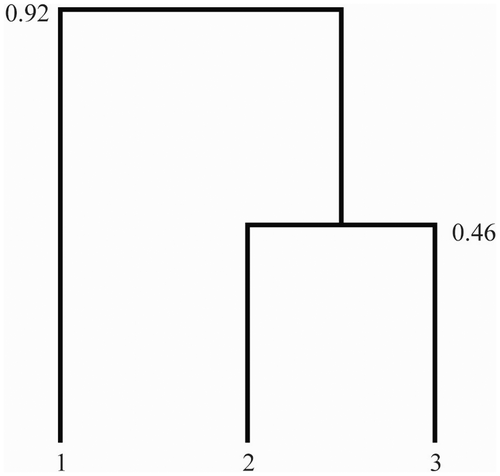
The research question on identifying value profiles was answered. There are specific characteristics of each country sample; samples are significantly different to form value profiles which can be compared. A tendency towards similarities of value profiles exists between countries.
5. Conclusion
Researchers and businessmen often recognise employees’ skills and personal strengths as an asset more valuable than financial capital, but hard to quantify. When investigating the contribution of individual values of employees to an economy and development, it is obvious that only with interdisciplinary research can an articulated approach be offered. In doing so, of course, strategic human resource management, planning, recruitment and selection of human resources do not lose their importance, but complement each other, because they themselves are not enough for effective management and rapid economic and social development challenges of regions and countries. In our research we offer a perspective that includes quantification of values and, as such, their understanding as an integral part of an asset called human capital.
Any (re)organisation of companies or local governments should involve understanding of its human resources, their skills and their values. In order to improve management, professionalise work and create new competencies, knowing the values of employees can contribute to better articulating the strategic objectives of municipalities and increasing the awareness of local resources. If there is an understanding of the values of employees, there is more chance that managers and employees will agree on the vision of the company or local development. It can, if properly transferred, motivate and empower employees and communities, but also affect their ambition and innovation and clarify responsibilities.
Research conducted in this paper confirmed its hypotheses. It showed that each region has its own specificity and its unique employee value profile. The difference between companies, local government units and positions in management in relation to responses on individual values has been shown. The combination of mathematical and statistical processing techniques showed that there are specific characteristics of each country sample, i.e. they are significantly different in order to form comparable value profiles. It was also shown that there are value profiles that can be seen as similar or significantly different from each other. Each region has values which rank higher than others, thus, defining value profiles.
For example, it is interesting to observe that similarity exists for Croatian and north Serbian value profiles, while Hungarian and Romanian value profiles are clearly distinct from other profiles. This information may be useful in understanding the employees’ work ethics, experience or priorities when, for example, deciding on investments in the region or initiating regional business clusters. Information on values should not be ignored when discussing the topicality of regional development. Value dimensions get a new meaning in relation to the objectives of human resources development of a particular region (for example in local government policies) and in selection of adequate management interventions at the local level. Companies may use information about employees’ values in order to fine tune their human resource management practices. Satisfied employees are basis of sustainable profitability. In this way, the individual values of employees may impact investments in human capital in the region.
This study is an attempt to emphasise the importance of managerial sensibility for the issue of employees’ values. Being in accordance with the concept of human resource development, the results of this study certainly open up further areas of research to understand values as an important ingredient of human capital. The limitations of this and similar research efforts are geographical, including a dependence on whether companies and local governments will open doors for such an investigation. Organising a nationwide (state-supported) research project would provide invaluable insight into the core of the nations’ most valuable resource – people. Until then, the next research step should include links with regional socio-economic development indicators and deeper analysis of the relationship between values as indicators of local organisational culture and the creation of a favourable investment climate of particular regions.
Disclosure statement
No potential conflict of interest was reported by the authors.
References
- Arsenijević, O., Bulatović, Lj, & Bulatović, G. (2012). The connection between values system and innovation of media students in Serbia, Croatia and Bosnia and Herzegovina. Praktični menadžment, 4, 7–15.
- Bilsky, W., Janik, M., & Schwartz, S. H. (2011). The structural organization of human values-evidence from three rounds of the European Social Survey (ESS). Journal of Cross-Cultural Psychology, 42, 759–776. doi:10.1177/0022022110362757
- Davidov, E., Schmidt, P., & Schwartz, S. H., (2008). Bringing values back in: The adequacy of the European social survey to measure values in 20 countries. Public Opinion Quarterly, 72, 420–445. Retrieved from http://dx.doi.org/10.1093/poq/nfn03510.1093/poq/nfn035
- Devos, T., Spini, D., & Schwartz, S. (2002). Conflicts among human values and trust in institutions. British Journal of Social Psychology, 41, 481–494.10.1348/014466602321149849
- Dolan, S. L., & Garcia, S. (2002). Managing by values, cultural redesign for strategic organizational change at the dawn of the 21st century. Journal of Management Development, 21, 101–117.10.1108/02621710210417411
- Dolan, S. L., Garcia, S., & Auerbach, A. (2003). Understanding and managing chaos in organisations. International Journal of Management, 20, 23–36.
- Gashi, L. M., Grubić-Nešić, L., Mitrović, S., Lajović, D., & Ćosić, I. (2013). The study of cultural values of employees in the region of Southeast Europe. Metalurgia International, 18, 136–139, ISSN 1582-2214.
- Grad, H. M. (2001). Los significados de la identidad nacional como valor personal [The significances of national identity as personal value]. In M. Ros & V. V. Gouveia (Eds.), Psicologia social de los values humanos: desarrollos Teóricos, metodológicos y aplicados (pp. 265–284). Madrid: Biblioteca Nueva.
- Henderson, G. (1994). Cultural diversity in the workplace, issues and strategies. Westport, Connecticut: Quorum Books.
- Hofstede, G., & Hofstede, G. J. (2005). Cultures and organizations: Software of the mind. New York, NY: McGraw-Hill.
- Jovović, R. (2006). Upravljanje putem vrijednosti i mjerenje perspektive vrijednosti u preduzeću [Management by values and measurement of value perspective in a company]. Strategijski menadžment, 11, 74–80.
- Menezes, I., & Campos, B. (1997). The process of value-meaning construction: A cross-sectional study. European Journal of Social Psychology, 27, 55–73.10.1002/(ISSN)1099-0992
- Milisavljević, S., Mitrović, S., Grubić-Nešić, L., Šimunović, G., Kozak, D., & Antić, A. (2013). The level of correlation between cultural values and system of customer relationship management. Technical Gazette, 20, 1037–1042. ISSN 1330-3651.
- Milosavljević, B. (2005). Sistem lokalne samouprave u Srbiji [The System of Local Self-government in Serbia]. Beograd: Stalna konferencija gradova i opština.
- Podrug, N., Filipović, D., & Stančić, I. (2014). Analysis of cultural differences between Croatia, Brazil, Germany and Serbia. Economic Research-Ekonomska Istraživanja, 27, 818–829. doi:10.1080/1331677X.2014.974915
- Randma-Liiv, T. (2005). Performance management in transitional administration: Introduction of pay-for-performance in the Estonian civil service. Journal of Comparative Policy Analysis, 7, 95–115.10.1080/13876980500084733
- Ros, M., & Schwartz, S. H. (1995). Jerarquia de valores en paises de la Europa Occidental: Una compacion trans-cultural [Hierarchy of Values in Western European Countries: A cross-cultural comparison]. Revista Española de Investigaciones Sociológicas, 69, 69–88.10.2307/40183777
- Sagiv, L., & Schwartz, S. H. (2000). Value priorities and subjective well-being: direct relations and congruity effects. European Journal of Social Psychology, 30, 177–198.10.1002/(ISSN)1099-0992
- Schwartz, S. H., (1992). Universals in the content and structure of values: Theory and empirical tests in 20 countries. In M. P. Zanna (Ed.), Advances in experimental social psychology (Vol. 25, pp. 1–65). New York, NY: Academic Press.
- Schwartz, S. H. (1994). Beyond individualism/collectivism: New dimensions of values. In U. Kim, H. C. Triandis, C. Kagitçibasi, S. C. Choi, & G. Yoon (Eds.), Individualism and collectivism: Theory application and methods (pp. 85–119). Newbury Park, CA: Sage.
- Schwartz, S. H. (2006). Value orientations: Measurement, antecedents and consequences across nations. In R. Jowell, C. Roberts, R. Fitzgerald, & G. Eva (Eds.), Measuring attitudes cross-nationally - lessons from the European Social Survey (pp. 161–193). London: Sage.
- Schwartz, S. H. (2012). An overview of the Schwartz theory of basic values. Online readings in psychology and culture. 2. Retrieved from http://dx.doi.org/10.9707/2307-0919.1116
- Schwartz, S. H., & Bardi, A. (2001). Value hierarchies across cultures: Taking a similarities perspective. Journal of Cross-Cultural Psychology, 32, 268–290.10.1177/0022022101032003002
- Schwartz, S. H., & Sagie, G. (2000). Value consensus and importance: A cross-national study. Journal of Cross-Cultural Psychology, 31, 465–497. doi:10.1177/0022022100031003001
- Schwartz, S. H., Melech, G., Lehmann, A., Burgess, S., & Harris, M. (2001). Extending the cross-cultural validity of the theory of basic human values with a different method of measurement. Journal of Cross-Cultural Psychology, 32, 519–542.10.1177/0022022101032005001
- Smith, P., Peterson, M., & Schwartz, S. H. (2002). Cultural values, sources of guidance and their relevance to managerial behaviour: a forty-seven nation study. Journal of Cross-Cultural Psychology, 33, 188–208.10.1177/0022022102033002005
- Spangler, W. D. (1992). Validity of questionnaire and TAT measures of need for achievement: Two meta-analyses. Psychological Bulletin, 112, 140–154.10.1037/0033-2909.112.1.140
- Struch, N., Schwartz, S. H., & van der Kloot, W. (2002). Meanings of basic values for women and men: A cross-cultural analysis. Personality and Social Psychology Bulletin, 28, 16–28. doi:10.1177/0146167209351886

